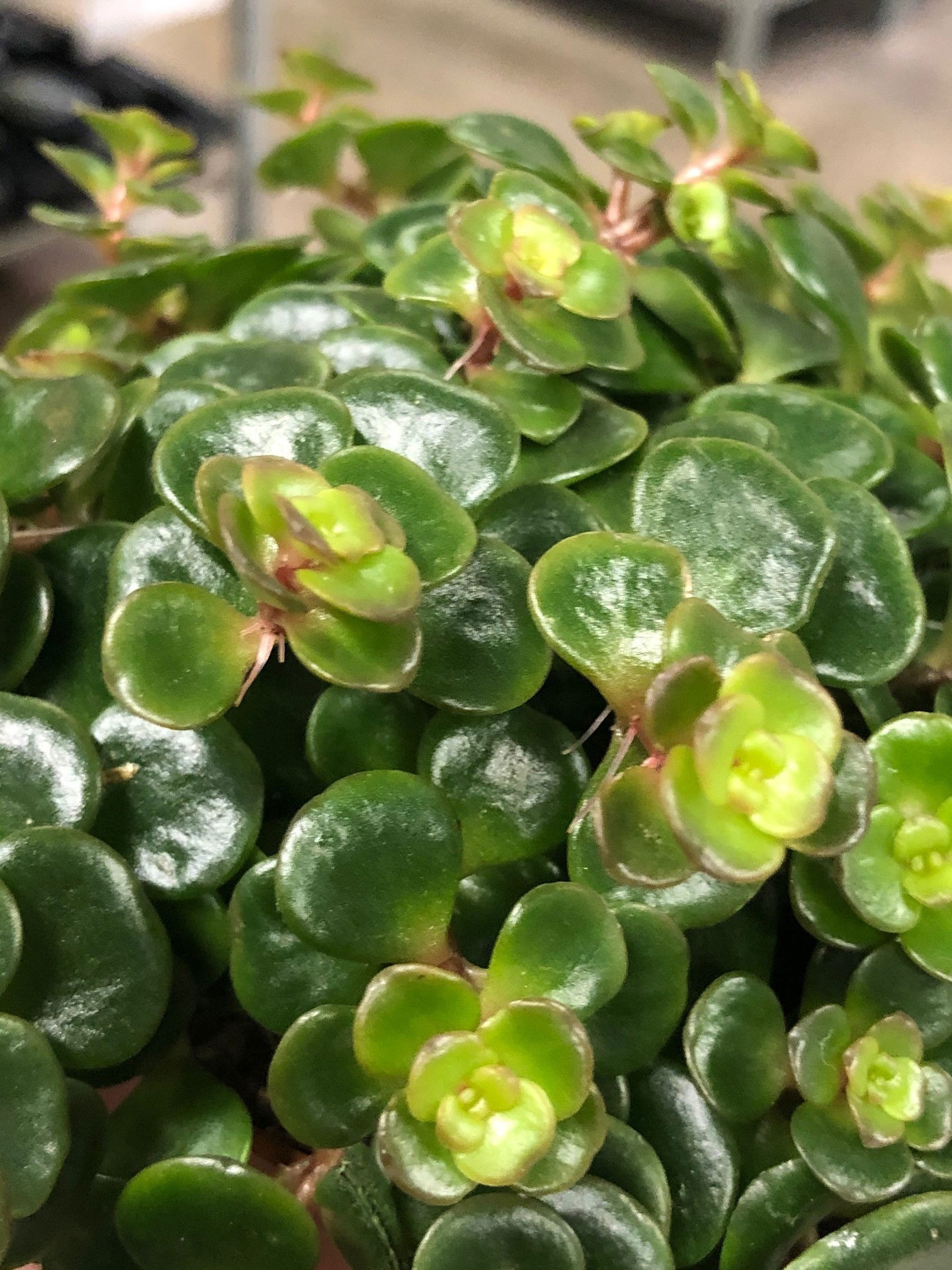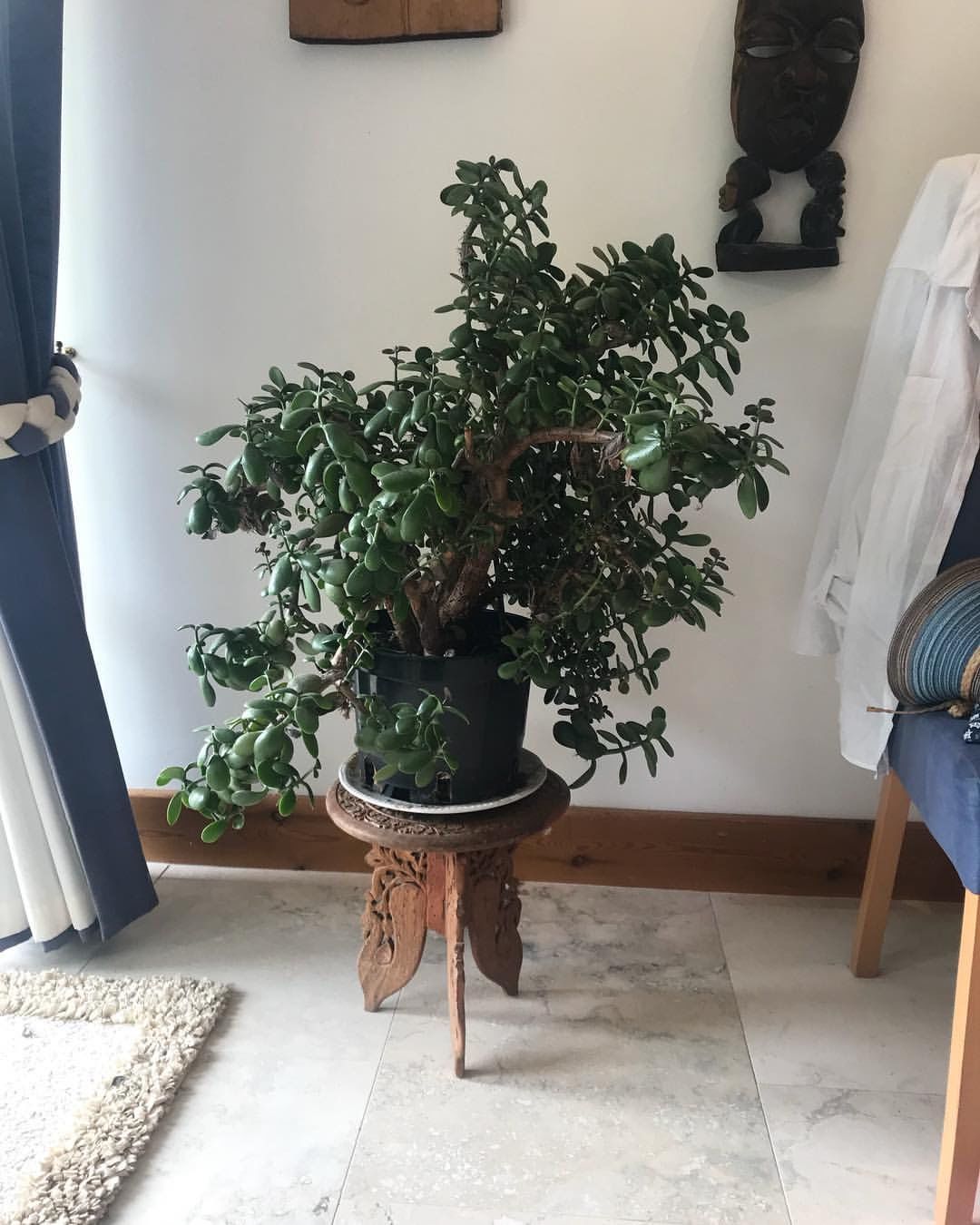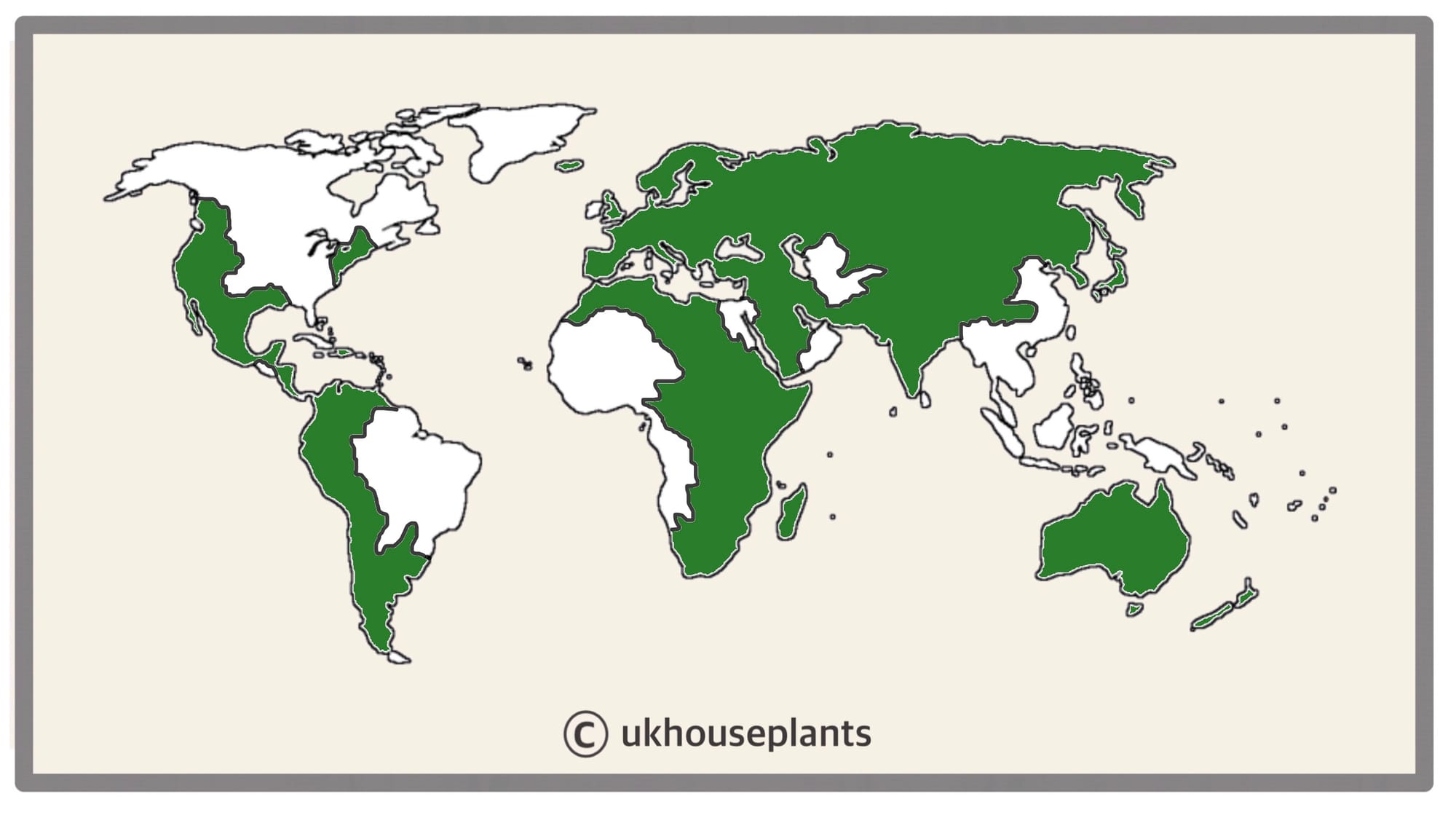
Crassula minor
Contents
- Top Tips
- Location, Water, Humidity & Fertilisation
- Common Issues
- Origins, Temperature, Propagation, Repotting & Toxicity.
Need the answer to a specific plant query? Book a 1-to-1 video call with Joe Bagley, the website's friendly author, to overcome and address your niggling problem! Available on iMessage, WhatsApp, Facebook Messenger & more.
Top Tips & Info
- Care Difficulty - Easy
- Be sure to provide a bright, indirect location with a possible splash of morning or evening sunlight throughout the winter period. For the remaining three seasons, avoid more than two hours of sun per day due to the risk of sun-scorch and dehydration.
- Allow all of the soil to dry out in between waters for the prevention of root rot. If you're stuck with when to water it, think of the ukhouseplants' phrase of 'Drenches Between Droughts'.
- Fertilise every two or three months using either a 'Cactus' or 'Houseplant' labelled feed.
- Repot every two or three years during the spring, using a Cactus & Succulent potting mix and the next sized pot with drainage holes.
- Keep an eye out for mealybugs that can inhabit the cubbyholes of the stem and leaves.
Location & Light - 🔸🔸🔸
Place the Crassula in a relatively bright location that offers a few hours of off-peak sunlight. Exposure to the sun will not only reduce the risk of over-watering, but it'll also maintain the colourful variegations of its foliage. Due to its intolerance of low light, situations, where a newspaper can't be read without the use of artificial light, must be avoided at all costs.
Water - 🔸
In its natural habitat, Crassula must endure torrential downpours between prolonged dry spells to survive. Keeping this in mind, rehydrate only once the soil's entirety has thoroughly dried out, reducing this further in the autumn and winter. If you have trouble knowing when to water appropriately, remember the ukhouseplants phrase; 'drenches between droughts'. For some varieties, pouring cold water directly into the soil could cause yellowed halos around the leaf edges that cannot be undone. Store tap water overnight in a non-metal container to bunk up the overall temperature, or use rainwater for the best results. Under-watering symptoms include shrivelling leaves and stems, little to no growth, gradual decline; these issues are usually caused by too much light or heat, a much needed repot or possible forgetfulness. Over-watering symptoms include yellowing leaves, a collapsed stem, wilting and plant death. Never situate your Crassula in a dark location; the combination of both too little light and too much soil moisture will slowly lead to root rot.
Humidity -
This is not a necessity; however, a quick hose down from time to time will hydrate the leaves and wash away dust or potential pests.
Fertilisation - 🔸
Fertilise every two months during the growing period and every three months in the autumn & winter to replicate its dormancy period. Although a 'Houseplant' fertiliser will still do the job, we'd recommend using a specific 'Cactus' labelled feed as it'll support the vital thirteen nutrients that this species will need to grow.
 Crassula rupestris (Kebab Bush) is a fast-growing succulent that can grow up to 20cm per year in the correct conditions.
Crassula rupestris (Kebab Bush) is a fast-growing succulent that can grow up to 20cm per year in the correct conditions.
Common Issues with Crassula
Reddened leaves are the product of too much sunlight, most common during the height of summer. A pigmentation called 'Carotenoids' will alter the appearance of the foliage to counteract the harsh effects of the UV rays. Although this isn't a permanent look, and the specimen will still function adequately, it'll grow far better and quicker in a slightly shadier location with only a splash of direct sun. Still providing an hour or so of bright light will lessen the effect of environmental shock and potential death.
Alternatively, root rot is a common issue among specimens sat in too dark environments with prolonged soil moisture. Symptoms include rapidly yellowing leaves, mouldy soil, stunted growth and a rotten brown base. Take the plant out of the pot and inspect health below the compost line. If the roots sport a yellow tinge, you're good to go, but those that are brown and mushy must be addressed immediately. More information about addressing root rot can be found on this link.
Clean the leaves regularly. Although this isn't too much of an issue, a build-up of dust particles can clog up the plant's pores, causing lowered light capturing-efficiency. Rinse the topsides of the leaves down once a month to keep levels down and improve growing conditions.
Never allow temperatures to dip below 10ºC (50ºF) as irreversible damage will occur in the likes of yellow foliage and weakened health. When this happens, remove the severely affected areas and immediately improve growing conditions - never cut through softened yellow or brown growth. As rehabilitation can take several months because of its slow-growing nature, be sure to provide a stable location with better growing conditions to speed this process.
Failed leaf-cuttings could be the product of several different reasons. As Crassula are best propagated during the spring when the plant is most active, those taken in the dormant months will root much slower, and could even die in the meantime. Study its environment - is there enough light to read a newspaper? If not, improve the growing conditions by increasing the amount of indirect sunlight it receives. Never situate the cuttings in direct sunlight as this will result in severe dehydration and most likely death. The overall size will play a big part in its success, too. The total height must surpass at least 8cm, with no visible signs of damage or cuts. Smaller specimens won't root appropriately due to the lower amounts of stored energy situated in the stem. If the leaves are propagated via hydroponics, replace the water weekly to prevent the risk of bacteria thriving within the container. Yellow or brown sections that are slowly rotting away must also be removed, as nasty pathogens will be released into the water, spreading onto unaffected specimens. Those directly placed in cold water will show signs of distress, too. If you're interested in propagating via soil, be sure to use a well-draining potting mix with a right amount of sand and grit. Those that are set too deeply or in excessive moist soil will begin to rot at the base, immediately reducing the chance of root development.
 A twenty-year-old Crassula ovata.
A twenty-year-old Crassula ovata.
Origins
Crassula is a genus that consists of two hundred species with natural distributions around the world, mostly in Southern Africa. The term, Crassula, derives from the Latin word for ‘thick’, referring to the plump leaves that store water for potential droughts. The popular, Crassula ovata, (Jade Tree) was first formally described in 1768 with ovata referring to the ‘egg’ shaped leaves.
Temperature
12° - 26°C (54° - 78°F)
H1b (Hardiness Zone 12) - Can be grown outdoors during the summer in a sheltered location with temperatures above 12℃ (54℉), but is fine to remain indoors, too. If you decide to bring this plant outdoors, don't allow it to endure any direct sunlight as it may result in sun-scorch and dehydration. Regularly keep an eye out for pests, especially when re-introducing it back indoors.
Spread
Up to 2m in height and 1.5m in width if repotted every other year. The ultimate height will take between 5 - 10 years to achieve, but can live for up to 30 years or more in the right care.
Pruning
Remove yellow or dying leaves, and plant debris to encourage better-growing conditions. While pruning, always use clean utensils or shears to reduce the chance of bacterial and fungal diseases. Never cut through yellowed tissue as this may cause further damage in the likes of diseases or bacterial infections. Remember to make clean incisions as too-damaged wounds may shock the plant, causing weakened growth and a decline in health.
Propagation
Leaf Cuttings (Easy) - Leaves that are halfway along the vine have the most potential due to their size and maturity. Gently place your fingers between the mother's stem and the leaf's base, pulling it downwards until you hear a snap. Ensure the wound is wholly intact with no damage, as a bruise or tear will result in unsuccessful propagation. Set the leaf ON TOP OF a bed of moist 'Cactus & Succulent' compost for root growth. Not only will this callus the wound (to prevent disease), but it'll also speed up the propagation process considerably. Once there are signs of small roots developing on the node, place it one third into the compost, at a slight angle. Provide a bright setting with temperatures around 18°C (64°F) with the majority of the soil drying out in between waters. New leaves should emerge within a month or two, thus signalling the start of its independent life!
Stem Cuttings (Easy) - Using a clean pair of scissors, cut a 5cm (2 inches) section off the stem's terminal. Be sure to use a fresh, damage or pest-free piece as unhealthy divisions are more likely to fail. Remove the older half of the leaves, so that the stem's lower portion is bare, to speed the process of root development. Purchase a 'Cactus & Succulent' compost and vertically push the cutting's base into the soil, avoiding the risk of covering the actual foliage with soil. Situate the cutting in a bright, indirect setting with temperatures above 18°C (64°F). As the roots will develop first, remove the bag and treat it as an adult specimen once there are signs of new foliar development.
Flowers
During mid-winter, matured specimens can produce small clusters of pink or white scented flowers that are around 2mm in size, lasting several weeks. Unfortunately, most Crassula won't flower in a domestic setting for many years due to the unfavourable growing conditions and time in which it takes to reach maturity.
Repotting
During the spring, repot every two or three years using 'Cactus & Succulent' compost and the next sized pot with drainage. This is an excellent time to check the roots' condition, as well as propagation if you desire. As Crassula are prone to root rot, have a look around the bottom half of the root ball for any brown or broken down roots caps. If this is the case, remove the affected areas with clean utensils and ease off with the irrigations; click on this link to learn more about how to perform the perfect transplant.
Book a 1-to-1 video call with Joe Bagley if you'd like a personal guide to repotting your houseplant. This will include recommending the right branded-compost and pot size, followed by a live video call whilst you transplant the specimen for step-by-step guidance and answer any further questions!
Pests & Diseases
Keep an eye out for mealybugs, spider mites, scale, fungus gnats, whitefly, vine weevils & root mealybugs that'll locate themselves in the cubbyholes and undersides of the leaves, with the exception of the latter two in the soil. Common diseases associated with Crassula are root rot, botrytis, rust, powdery mildew & southern blight - click here to learn more about these issues.
Toxicity
This plant is slightly poisonous. If parts of the plants are eaten, vomiting, nausea and a loss of appetite could occur. Consumption of large quantities must be dealt with quickly; acquire medical assistance for further information.
Retail Locations
Blue Diamond, Dobbies, IKEA & Online Stores.
Book a 1-to-1 Call with Joe Bagley
If you need further advice with your houseplants, book an advice call with ukhouseplants' friendly and expert writer today! This can be done via a video or audio call on most apps, including Facebook, FaceTime & Skype. A ten-minute call costs £5.99 (US$7), or £15.99 for thirty minutes. You can ask multiple questions, including queries on plants, pests, terrariums, repotting advice and anything in between. Please consider supporting this service to keep ukhouseplants thriving!
